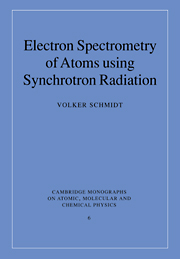Book contents
- Frontmatter
- Contents
- Corrigenda and Addenda
- Dear Reader
- Part A Background and basic principles
- 1 Introduction
- 2 Photoelectron spectrum of neon
- 3 Auger spectrum of neon following 1s ionization
- Part B Experimental aspects and recent examples
- Part C Details of specific experimental and theoretical topics
- References
- Index
3 - Auger spectrum of neon following 1s ionization
Published online by Cambridge University Press: 21 October 2009
- Frontmatter
- Contents
- Corrigenda and Addenda
- Dear Reader
- Part A Background and basic principles
- 1 Introduction
- 2 Photoelectron spectrum of neon
- 3 Auger spectrum of neon following 1s ionization
- Part B Experimental aspects and recent examples
- Part C Details of specific experimental and theoretical topics
- References
- Index
Summary
Description of the K–LL Auger spectrum
Inner-shell ionization is accompanied by subsequent radiative and non-radiative decay. In the context of electron spectrometry, the non-radiative or Auger decay is of special interest, because the emitted Auger electron can be detected. After some remarks on the general description and classification of Auger transitions following 1s ionization in neon, the calculation of K–LL Auger transition rates and the formulation of intermediate coupling in the final ionic state of the K–LL Auger transition will be addressed. This information then provides the basis for a detailed analysis of the experimental K–LL Auger spectrum of neon which is organized similarly to the previous discussion of photoelectrons: namely, with respect to line positions, linewidths, line intensities, and angular distributions.
General aspects
In addition to the photoelectron lines, other discrete structures appear in the electron spectrum of neon if the photon energy is higher than the threshold for 1s ionization. These lines are due to radiationless transitions called Auger transitions [Aug25]; the 1s-hole created by photoionization is filled by a subsequent two-electron transition induced by the Coulomb interaction between the electrons. This interaction causes one outer-shell electron to jump down, filling the 1s-hole, simultaneously ejecting another outer-shell electron, the Auger electron, into the continuum. This process has been sketched schematically in Figs. 1.3 and 2.5.
- Type
- Chapter
- Information
- Publisher: Cambridge University PressPrint publication year: 1997
- 1
- Cited by



